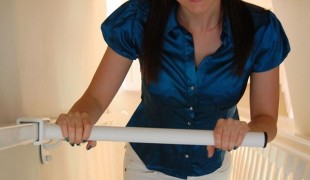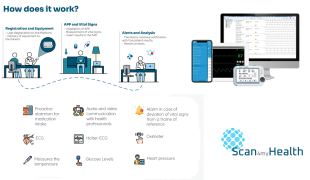- 7620
- 427
- 8
- 10
- 0
- Help Ukraine
About the solution
The cane's functions include a flashlight, pulse monitor, and smartphone-connected medication reminder. "What's so cool about our generation," Mary says, "is that we can start using technology to revolutionize these very basic necessities of life."
“I guess I got the idea from my grandma,” she says, regarding the cane. “She’s 84 and she’s visually impaired. I felt that technology could really make a difference for her.” The teen did research, and part of it was talking the problem over with nurses and doctors who work with the elderly. Then the she thought hard about what a good cane should do.
Mary knew that the biggest risk for the elderly was falling. So she wanted to design a device that could sense when pavement changes — tripping hazards — lay ahead and then alert the user. She also knew that older people can fall if their blood pressure drops and makes them dizzy. So Mary wanted her cane to track that as well.
Her new “smart” cane is full of sensors. Some measure elevation by sending out tiny pulses of very high-pitched sound — a frequency that humans cannot hear. That sound bounces off of objects ahead, such as a coffee table, and then returns to the sensor. By measuring the time it takes for the sound to return, the cane can calculate how far away the coffee table is. If the cane gets too close, its sensors make the cane handle vibrate, warning the walker to watch out.
Gripping the cane’s handle can collect data on how fast a user’s heart is beating. If it’s too high or too low, the user may be at risk of fainting. So the cane will vibrate and let its user know that it’s time to find a seat and rest. The cane also comes equipped with lights and a computer. That computer can be programmed to notify users when it’s time to take any medication.
Adapted from: http://bit.ly/2hmBf1Z
https://www.youtube.com/watch?v=SExY-8uHdgk
This solution shall not include mention to the use of drugs, chemicals or biologicals (including food); invasive devices; offensive, commercial or inherently dangerous content. This solution was not medically validated. Proceed with caution! If you have any doubts, please consult with a health professional.
DISCLAIMER: This story was written by someone who is not the author of the solution, therefore please be advised that, although it was written with the utmost respect for the innovation and the innovator, there can be some incorrect statements. If you find any errors please contact the patient Innovation team via info@patient-innovation.com
-
-
173
-
0
-
2382

Collaborator Pierluigi Mantovani creates Evolution Devices - solutions that aim to transform Multiple Sclerosis Management
CAREGIVING
BODY BALANCE: Maintaining body balance
STANDING UP: Standing up from a seated position
WALKING: Walking
Multiple Sclerosis
Assistive Daily Life Device (to help ADL)
Walking Aid (wheelchair/walker/crutches)
App (Including when connected with wearable)
AI algorithm
Body-Worn solutions (Clothing, accessories, shoes, sensors...)
Restoring mobility
Regaining sensory function
Managing pain
Promoting self-management
Preserving Organ Function
Managing Neurological Disorders
Maintaining Balance and Mobility
To improve Treatment/Therapy
Preventing (Vaccination, Protection, Falls, Research/Mapping)
Raise awareness
Caregiving Support
General and Family Medicine
Internal Medicine
Medical Genetics
Neurology
Physical Medicine and Rehabilitation
United States
-
-
-
309
-
0
-
14638

15-year-old develops innovative stair climbing device
BODY BALANCE: Maintaining body balance
WALKING WITH A WALKING AID: Walking with a walking aid
Assistive Daily Life Device (to help ADL)
Walking Aid (wheelchair/walker/crutches)
Difficulty climbing slopes
Impaired movement
Loss of balance
Difficulty walking or moving
Promoting self-management
Maintaining Balance and Mobility
Preventing (Vaccination, Protection, Falls, Research/Mapping)
Neurology
Physical Medicine and Rehabilitation
Rheumatology
Aging
Mobility issues
Solutions for Disabled people
United Kingdom
-
-
-
154
-
1
-
1919

Scan4myHealth | Real-time solution for monitoring patient vital signs
CAREGIVING
COMMUNICATION: Communicating, whether by speaking, listening, or other means
Stroke
App (Including when connected with wearable)
AI algorithm
Assistive Daily Life Device (to help ADL)
Promoting self-management
To implement medical examination
Restoring heart health
Managing diabetes
Manage Medication
Rehabilitating After Stroke
Preventing (Vaccination, Protection, Falls, Research/Mapping)
Caregiving Support
Cardiology
General and Family Medicine
Internal Medicine
Physical Medicine and Rehabilitation
Pneumology
Portugal
-
 en
en